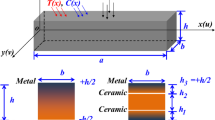Abstract
A simple computation procedure is developed to predict the general behaviour of reinforced concrete beams under torsion. Both plain and hollow normal strength concrete beams are considered. Different theoretical models are used to reflect the actual behaviour of the beams in the various phases of loading. To pass from a phase to the following one, transition criteria need to be taken into consideration. Such criteria are explained. The theoretical predictions are compared with result from reported tests. Conclusions are presented. The main conclusion is that the calculation procedure described in this paper gives good predictions when compared with the actual behaviour of the plain and hollow beams.



































Similar content being viewed by others
References
ACI Committee 318 (1995) Building Code Requirements for Reinforced Concrete, (ACI 318-95), American Concrete Institute, Detroit, MI
ACI Committee 318 (2005) Building Code Requirements for Reinforced Concrete, (ACI 318-05), American Concrete Institute, Detroit, MI
Andersen P (1935) Experiments with concrete in torsion. Trans ASCE 100:949–983
Bernardo LFA (2003) Torção em Vigas em Caixão de Betão de Alta Resistência (Torsion in reinforced high-strength concrete hollow beams). Ph.D. Thesis, University of Coimbra, Portugal
CEB (1969) Torsion. Bulletin d’Information No. 71, Mars
CEB-FIP (1978) Model code for concrete structures. CEB-FIP International Recommendations, 3rd edn. Paris, 348 pp
CEB-FIP MODEL CODE (1990) Comité Euro-International du Béton, Suisse
CEN prEN 1992-1-1 (2002) Eurocode 2: design of concrete structures—Part 1: general rules and rules for buildings, April 2002
Collins MP (1973) Torque-twist characteristics of reinforced concrete beams. Inelasticity and non-linearity in Structural Concrete Study No. 8. University of Waterloo Press, Waterloo, Ontario, Canada, pp 211–232
Collins MP, Mitchell D (1980) Shear and torsion design of prestressed and non-prestressed concrete beams. J Prestressed Concrete Inst Proc 25(5):32–100
Cowan HJ (1950) Elastic Theory for torsional strength of rectangular reinforced concrete beams. Mag Concrete Res Lond 2(4): 3–8
Elfgren L (1972) Reinforced concrete beams loaded in combined torsion, bending and shear publication 71:3 division of concrete structures. Chalmers University of Technology, Goteborg Sweden, 249 pp
Hsu TTC (1968) Torsion of structural concrete—Behavior of reinforced concrete rectangular members torsion of structural concrete SP-18. American Concrete Institute, Detroit, pp 261–306
Hsu TTC (1973) Post-cracking torsional stiffness of reinforced concrete sections. J Am Concrete Inst Proc 70(5):352–360
Hsu TTC (1979) Discussion of pure torsion in rectangular sections—A re-examination. In: McMullen AE, Rangan BV, J Am Concrete Inst Proc 76(6):741–746
Hsu TTC (1984) Torsion of reinforced concrete. Van Nostrand Reinhold Company
Hsu TTC, Mo YL (1985) Softening of concrete in torsional members—Theory and tests. J Am Concrete Inst Proc 82(3):290–303
Hsu TTC, Mo YL (1985) Softening of concrete in torsional members—Design recommendations. J Am Concrete Inst Proc 82(4):443–452
Lampert P, Thurlimann B (1969) Torsionsversuche an Stahlbetonbalken (Torsion tests of reinforced concrete beams) Bericht Nr 6506-2. Institut fur Baustatik, ETH Zurich, 101 pp
Leonhardt F, Schelling G (1974) Torsionsversuche an Stahl Betonbalken Bulletin No. 239. Deutscher Ausschuss fur Stahlbeton, Berlin, 122 pp
MacGregor JG, Ghoneim MG (1995) Design for Torsion. J Am Concrete Inst Proc 92(2):211–218
McMullen AE, Rangan BV (1978) Pure torsion in rectangular sections—A re-examination. J Am Concrete Inst 75(10):511–519
Mitchell D, Collins MP (1974) The behavior of structural concrete beams in pure torsion. Civil Engineering Publication No. 74-06, Department of civil Engineering, University of Toronto, 88 pp
Mitchell D, Collins MP (1974) Diagonal compression field theory—A rational model for structural concrete in pure torsion. J Am Concrete Inst Proc 71(8):396–408
Rahal KN, Collins MP (1995) Effect of thickness of concrete cover on shear-torsion interaction—An experimental investigation. J Am Concrete Inst Proc 92(3):334–342
Rahal KN, Collins MP (1995) Analysis of sections subjected to combined shear and torsion—A theoretical model. ACI Struct J 92(4):459–469
Rahal KN, Collins MP (1996) Simple model for predicting torsional strength of reinforced and prestressed concrete sections. J Am Concrete Inst Proc 93(6):658–666
Rahal KN, Collins MP (2003) Combined torsion and bending in reiinforced and prestressed concrete beams. ACI Struct J 100(2):157–165
Rausch E (1929) Berechnung des Eisenbetons gegen Verdrehung (Design of reinforced concrete in torsion). Ph.D. Thesis, Berlin, 53 pp
Standards Council of Canada (2004) Design of concrete structure for buildings. CAN3-A23.3-04, Canadian Standards Association, Mississanga, Canada
Vecchio FJ, Collins MP (1981) Stress-strain characteristics of reinforced concrete in pure shear. IABSE Colloquium, Advanced Mechanics of Reinforced concrete, Delft, Final Report, pp 211–225
Vecchio FJ, Collins MP (1982) The response of reinforced concrete to in-plane shear and normal forces. Publication No. 82-03. Department of Civil Engineering, University of Toronto
Vecchio FJ, Collins MP (1986) The modified compression field theory for reinforced concrete elements subjected do shear. J Am Concrete Inst 83:219–231
Author information
Authors and Affiliations
Corresponding author
Rights and permissions
About this article
Cite this article
Bernardo, L.F.A., Lopes, S.M.R. Behaviour of concrete beams under torsion: NSC plain and hollow beams. Mater Struct 41, 1143–1167 (2008). https://doi.org/10.1617/s11527-007-9315-0
Received:
Accepted:
Published:
Issue Date:
DOI: https://doi.org/10.1617/s11527-007-9315-0




